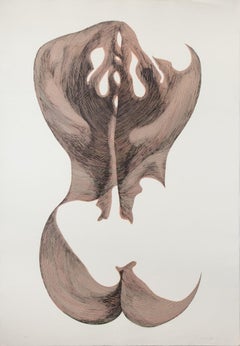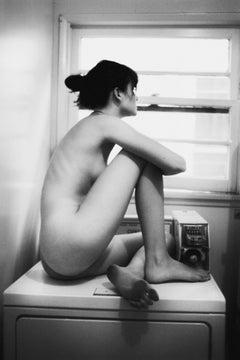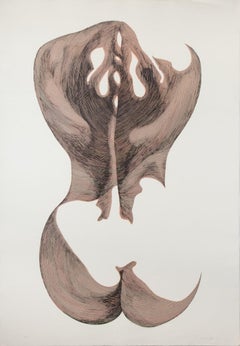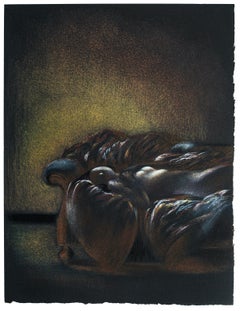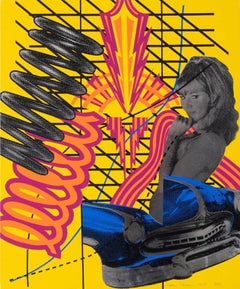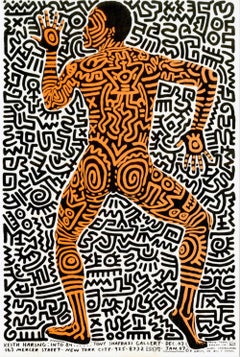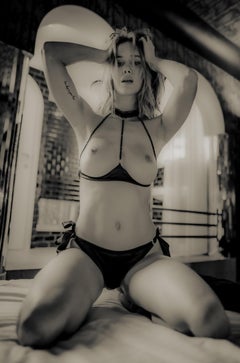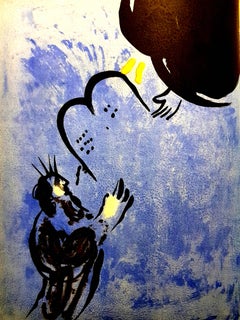Electronics Nude Prints
to
1
1
3
1
Overall Width
to
Overall Height
to
3
1
1
3
1
1
1
5
1
1
3
1
6
882
1,955
1,209
897
767
511
465
392
367
279
103
96
74
67
54
48
47
45
40
39
3
1
1
1
1
4
2
Art Subject: Electronics
Price - Woman from Shouldes - Original Etching by Giacomo Porzano - 1970s
Located in Roma, IT
Woman from Shoulders is an etching on paper, realized by the Italian artist Giacomo Porzano (1925-2006).
Hand-signed on the lower right.
Numbered edition, 11/20.
In good condition...
Category
1970s Contemporary Figurative Prints
Materials
Etching
"Lovesick" Black & White Photography 45" x 30" in Edition 1/7 by Larsen Sotelo
Located in Culver City, CA
"Lovesick" Black & White Photography 45" x 30" in Edition 1/7 by Larsen Sotelo
Not framed. Ships in a tube
Comes with COA
Available sizes:
Edition of 15: 36" x 24" inch
Edition...
Category
21st Century and Contemporary Modern Nude Prints
Materials
Archival Ink, Rag Paper, Giclée
Woman from the Back - Original Etching by Giacomo Porzano - 1970s
Located in Roma, IT
Woman from the backis an etching on paper, realized by the Italian artist Giacomo Porzano (1925-2006).
Hand-signed on the lower right.
Numbered edition,10/20.
In good condition
...
Category
1970s Contemporary Figurative Prints
Materials
Etching
Woman from the Back - Etching by Giacomo Porzano - 1970s
Located in Roma, IT
Woman from Shoulders is an etching on paper, realized by the Italian artist Giacomo Porzano (1925-2006).
Hand-signed on the lower right.
Numbered edition, 2/20.
In good condition ...
Category
1970s Contemporary Figurative Prints
Materials
Etching
Femme Nue Allongée sur Canapé - Original Lithograph by B. Kelly - 1980s
Located in Roma, IT
Femme Nue Allongée sur Canapé is a sensual color lithograph realized by Bernadette Kelly (1933-) in the 20th century.
Dimensions: cm 32 x 24. Very good conditions.
Category
1980s Figurative Prints
Materials
Lithograph
Custom Pop Art Screenprint I from "11 Pop Artists" by Peter Phillips
Located in Long Island City, NY
Artist: Peter Phillips, British (1939 - )
Title: Custom Print I from 11 Pop Artists
Year: 1965
Medium: Silkscreen, signed and numbered in pencil
Edition: 200, XXII/L
Size: 24 x 19.5...
Category
1960s Pop Art Nude Prints
Materials
Screen
Related Items
Keith Haring Into 84 (Keith Haring Tony Shafrazi announcement card)
By Keith Haring
Located in NEW YORK, NY
Keith Haring Painted Man:
Original 1983 announcement card for Keith Haring’s well-documented exhibition, Keith Haring 'Into 84' at Tony Shafrazi Gallery, New York, 1983. For this series Haring borrowed Jones' body — from head to toe — as the canvas to his work. A bodily canvas defined by much of the bold pictograms characteristic of Haring's artistic signature. Photos by Haring's long-time friend and collaborator Tseng Kwong Chi.
Off-set printed, 1983.
Dimensions: 6 x 4 inches.
Some minor fading to the reverse; otherwise very good overall condition with strong colors.
Literature: Keith Haring: Posters (Prestel pub.)
Further About
In 1983 Keith Haring teamed up with award-winning choreographer and dancer Bill T. Jones, founder of the Bill T. Jones/Arnie Zane Dance Company. Keith and Bill met in London in 1983 at a time when the graffiti artist was opening a major show at the Robert Fraser Gallery, and together they produced a series of exceptional collaborations in both performance and drawing.
Related Categories
Keith Haring dancer. Ballet. Keith Haring Figurative Drawings. Keith Haring Into 84 poster. Keith Haring and Tony Shafrazi. Haring Shafrazi.
Category
1980s Pop Art Nude Prints
Materials
Offset, Lithograph
H 6 in W 4 in D 0.01 in
Room 408 - Collector Portfolio # 1 out 7 - 12 Fine Art Prints Nude photography
Located in Brussels, BE
His series "Room" or "My carnival" evokes the fantasy of the mistress, fetishist eroticism, 5 to 7, free fantasy. Eric produces erotic art without ever biting into porn-chic always being more obsessed with aesthetics than with simulacrum. If he worships more than one of these predecessors who poured into more outrage, it is freely that he suggests to the imagination to imagine without capturing the fantasy of the viewer.
The choice had been made of very high quality prints: cotton fiber base baryta paper without chlorine and high grammage (310 gr / m²), pigment inks. They carry on the back an authentication label signed by Eric Ceccarini
The enhancement of this limited edition of 100 copies is ensured by the use of a unique high-quality box to keep the 12 fine art prints
this is edition 2/100
Eric is a Belgian artist born in 1965. He gained a Degree in Photography from INFAC, Brussels in 1987. Since then he has been a fashion photographer working with many of the top houses. Elle, Marie-Claire, L'Oréal, Levi's, Coca Cola, Virgin, Saab, Delvaux, Lowe Lintas and Ogilvy are some of his clients.
Among other distinctions, his photography for the Saab cabrio 9-3 campaign was awarded the Silver Lion at the Cannes International Advertising Festival.
Eric is set apart from many of his colleagues by his way of shunning technical artifice and working in natural light. This results in soft, velvety, almost painterly images.
Nowadays in his artistic works, he captures women's essence and soul, transcending mere physical representation.
Eric's "AMNIOS" series of soul portraits- the model appear in suspended animation, as if they were about to born, and full of hidden secrets. This
represents a new conceptual departure for Eric, who began as a fashion photographer, moving on to classic artistic nudes...
Category
2010s Contemporary Nude Photography
Materials
Archival Pigment, Rag Paper
H 8.27 in W 11.82 in D 0.12 in
The Creation of Eve
Located in London, GB
Original Colour lithograph on wove paper
hand-signed and numbered by the artist
edition 950 of 1000
49 x 48 cm
contained in the portfolio 'Del Calendario 5 artistes Catalans'
catal...
Category
1970s Surrealist Figurative Prints
Materials
Lithograph
Shiny Nude screen print 1977
Located in Brooklyn, NY
"Shiny Nude" by Tom Wesselmann, published by Parasol Press LTD. and printed by A. Colish Press, stands out for its glossy finish and vibrant depiction of th...
Category
1970s Pop Art Figurative Prints
Materials
Screen
Room 2 - Collector Portfolio # 5 out 7 - 12 Fine Art Prints Nude photography
Located in Brussels, BE
His series "Room" or "My carnival" evokes the fantasy of the mistress, fetishist eroticism, 5 to 7, free fantasy. Eric produces erotic art without ever biting into porn-chic always being more obsessed with aesthetics than with simulacrum. If he worships more than one of these predecessors who poured into more outrage, it is freely that he suggests to the imagination to imagine without capturing the fantasy of the viewer.
The choice had been made of very high quality prints: cotton fiber base baryta paper without chlorine and high grammage (310 gr / m²), pigment inks. They carry on the back an authentication label signed by Eric Ceccarini
The enhancement of this limited edition of 100 copies is ensured by the use of a unique high-quality box to keep the 12 fine art prints
This is edition #6/100
Eric is a Belgian artist born in 1965. He gained a Degree in Photography from INFAC, Brussels in 1987. Since then he has been a fashion photographer working with many of the top houses. Elle, Marie-Claire, L'Oréal, Levi's, Coca Cola, Virgin, Saab, Delvaux, Lowe Lintas and Ogilvy are some of his clients.
Among other distinctions, his photography for the Saab cabrio 9-3 campaign was awarded the Silver Lion at the Cannes International Advertising Festival.
Eric is set apart from many of his colleagues by his way of shunning technical artifice and working in natural light. This results in soft, velvety, almost painterly images.
Nowadays in his artistic works, he captures women's essence and soul, transcending mere physical representation.
Eric's "AMNIOS" series of soul portraits- the model appear in suspended animation, as if they were about to born, and full of hidden secrets. This
represents a new conceptual departure for Eric, who began as a fashion photographer, moving on to classic artistic nudes, now showing us the
nude in the ethereal form. These forms are certainly beautiful, yet a membrane, whose function is unclear, separates them from us: is it to hide, or protect? In person, these works are monumental in scale, adding to their sense of restrained power.
In the "NUDES" series, Eric uses only natural light, just as a traditional painter would do in their study. Using slow exposure speeds which allow the lens more time to capture each model's unique character, he reveals a sense of the sublime feminine, which borders on abstraction. Eric's nudes are the same, yet different. They are all beautiful, yet their differences and unique qualities are magnified. "NUDES" is a series that celebrates the human form.
For "PAINTERS", Eric collaborates with a different painter for each photograph. More than 100 of them have been invited throughout Europe and the other continents. The artist paints the model in their own style, while Eric searches for attitudes, then he photographs the result. In this way, the Painters series represents a fusion of two artistic visions - something that's not always easy to achieve, yet this series epitomizes a sense of cohesion and dynamic ynchronicity.
His work has been exhibited in Belgium, United Kingdom, France, Switzerland, The US , China, Singapore, The Netherlands, Germany, Spain…
Current galleries where Eric is permanently resident:
USA
——
New-York city
Galerie L’Atelier / Fremin Gallery
Greenwich, Connecticut
Galerie L’Atelier / Emmanuelle G Gallery...
Category
2010s Contemporary Nude Photography
Materials
Rag Paper, Archival Pigment
H 8.27 in W 11.82 in D 0.12 in
Room 3 - Collector Portfolio # 7 out 7 - 15 Fine Art Prints Nude photography
Located in Brussels, BE
His series "Room" or "My carnival" evokes the fantasy of the mistress, fetishist eroticism, 5 to 7, free fantasy. Eric produces erotic art without ever biting into porn-chic always being more obsessed with aesthetics than with simulacrum. If he worships more than one of these predecessors who poured into more outrage, it is freely that he suggests to the imagination to imagine without capturing the fantasy of the viewer.
The choice had been made of very high quality prints: cotton fiber base baryta paper without chlorine and high grammage (310 gr / m²), pigment inks. They carry on the back an authentication label signed by Eric Ceccarini
The enhancement of this limited edition of 100 copies is ensured by the use of a unique high-quality box to keep the 12 fine art prints
This is edition #1/100
Eric is a Belgian artist born in 1965. He gained a Degree in Photography from INFAC, Brussels in 1987. Since then he has been a fashion photographer working with many of the top houses. Elle, Marie-Claire, L'Oréal, Levi's, Coca Cola, Virgin, Saab, Delvaux, Lowe Lintas and Ogilvy are some of his clients.
Among other distinctions, his photography for the Saab cabrio 9-3 campaign was awarded the Silver Lion at the Cannes International Advertising Festival.
Eric is set apart from many of his colleagues by his way of shunning technical artifice and working in natural light. This results in soft, velvety, almost painterly images.
Nowadays in his artistic works, he captures women's essence and soul, transcending mere physical representation.
Eric's "AMNIOS" series of soul portraits- the model appear in suspended animation, as if they were about to born, and full of hidden secrets. This
represents a new conceptual departure for Eric, who began as a fashion photographer, moving on to classic artistic nudes...
Category
2010s Contemporary Nude Photography
Materials
Archival Pigment, Rag Paper
H 8.27 in W 11.82 in D 0.12 in
Room 217 - Collector Portfolio # 4 out 7 - 12 Fine Art Prints Nude photography
Located in Brussels, BE
His series "Room" or "My carnival" evokes the fantasy of the mistress, fetishist eroticism, 5 to 7, free fantasy. Eric produces erotic art without ever biting into porn-chic always being more obsessed with aesthetics than with simulacrum. If he worships more than one of these predecessors who poured into more outrage, it is freely that he suggests to the imagination to imagine without capturing the fantasy of the viewer.
The choice had been made of very high quality prints: cotton fiber base baryta paper without chlorine and high grammage (310 gr / m²), pigment inks. They carry on the back an authentication label signed by Eric Ceccarini
The enhancement of this limited edition of 100 copies is ensured by the use of a unique high-quality box to keep the 12 fine art prints
Eric is a Belgian artist born in 1965. He gained a Degree in Photography from INFAC, Brussels in 1987. Since then he has been a fashion photographer working with many of the top houses. Elle, Marie-Claire, L'Oréal, Levi's, Coca Cola, Virgin, Saab, Delvaux, Lowe Lintas and Ogilvy are some of his clients.
Among other distinctions, his photography for the Saab cabrio 9-3 campaign was awarded the Silver Lion at the Cannes International Advertising Festival.
Eric is set apart from many of his colleagues by his way of shunning technical artifice and working in natural light. This results in soft, velvety, almost painterly images.
Nowadays in his artistic works, he captures women's essence and soul, transcending mere physical representation.
Eric's "AMNIOS" series of soul portraits- the model appear in suspended animation, as if they were about to born, and full of hidden secrets. This
represents a new conceptual departure for Eric, who began as a fashion photographer, moving on to classic artistic nudes...
Category
2010s Contemporary Nude Photography
Materials
Archival Pigment, Rag Paper
H 8.27 in W 11.82 in D 0.12 in
Room 2 - Collector Portfolio # 5 out 7 - 12 Fine Art Prints Nude photography
Located in Brussels, BE
His series "Room" or "My carnival" evokes the fantasy of the mistress, fetishist eroticism, 5 to 7, free fantasy. Eric produces erotic art without ever biting into porn-chic always being more obsessed with aesthetics than with simulacrum. If he worships more than one of these predecessors who poured into more outrage, it is freely that he suggests to the imagination to imagine without capturing the fantasy of the viewer.
The choice had been made of very high quality prints: cotton fiber base baryta paper without chlorine and high grammage (310 gr / m²), pigment inks. They carry on the back an authentication label signed by Eric Ceccarini
The enhancement of this limited edition of 100 copies is ensured by the use of a unique high-quality box to keep the 12 fine art prints
This is edition #6/100
Eric is a Belgian artist born in 1965. He gained a Degree in Photography from INFAC, Brussels in 1987. Since then he has been a fashion photographer working with many of the top houses. Elle, Marie-Claire, L'Oréal, Levi's, Coca Cola, Virgin, Saab, Delvaux, Lowe Lintas and Ogilvy are some of his clients.
Among other distinctions, his photography for the Saab cabrio 9-3 campaign was awarded the Silver Lion at the Cannes International Advertising Festival.
Eric is set apart from many of his colleagues by his way of shunning technical artifice and working in natural light. This results in soft, velvety, almost painterly images.
Nowadays in his artistic works, he captures women's essence and soul, transcending mere physical representation.
Eric's "AMNIOS" series of soul portraits- the model appear in suspended animation, as if they were about to born, and full of hidden secrets. This
represents a new conceptual departure for Eric, who began as a fashion photographer, moving on to classic artistic nudes, now showing us the
nude in the ethereal form. These forms are certainly beautiful, yet a membrane, whose function is unclear, separates them from us: is it to hide, or protect? In person, these works are monumental in scale, adding to their sense of restrained power.
In the "NUDES" series, Eric uses only natural light, just as a traditional painter would do in their study. Using slow exposure speeds which allow the lens more time to capture each model's unique character, he reveals a sense of the sublime feminine, which borders on abstraction. Eric's nudes are the same, yet different. They are all beautiful, yet their differences and unique qualities are magnified. "NUDES" is a series that celebrates the human form.
For "PAINTERS", Eric collaborates with a different painter for each photograph. More than 100 of them have been invited throughout Europe and the other continents. The artist paints the model in their own style, while Eric searches for attitudes, then he photographs the result. In this way, the Painters series represents a fusion of two artistic visions - something that's not always easy to achieve, yet this series epitomizes a sense of cohesion and dynamic ynchronicity.
His work has been exhibited in Belgium, United Kingdom, France, Switzerland, The US , China, Singapore, The Netherlands, Germany, Spain…
Current galleries where Eric is permanently resident:
USA
——
New-York city
Galerie L’Atelier / Fremin Gallery
Greenwich, Connecticut
Galerie L’Atelier / Emmanuelle G Gallery...
Category
2010s Contemporary Nude Photography
Materials
Rag Paper, Archival Pigment
H 8.27 in W 11.82 in D 0.12 in
Nus Bleus VII, from 1958 The Last Works of Henri Matisse
Located in Washington, DC
Artist: Henri Matisse (after)
Title: Nus Bleus VII
Portfolio: The Last Works of Henri Matisse
Medium: Lithograph
Year: 1958
Edition: 2000
Frame Size: 22" x 18"
Sheet Size: 14" x 10 ...
Category
1950s Figurative Prints
Materials
Lithograph
Water Horn, by Mark Jenkins
By Mark Jenkins
Located in Palm Springs, CA
Traditional photographic techniques mixed with digital manipulation work to create slightly surreal homoerotic imagery for the prints in Jenkins' Liquid series. Signed, titled and nu...
Category
Early 2000s Contemporary Nude Prints
Materials
Digital
Helen Nude /// Tom Wesselmann Screenprint Nude Pop Art Flowers Interior Room
Located in Saint Augustine, FL
Artist: Tom Wesselmann (American, 1931-2004)
Title: "Helen Nude"
*Signed, dated, and numbered by Wesselmann in pencil lower right
Year: 1981
Medium: Original Screenprint on heavy unb...
Category
1980s Pop Art Nude Prints
Materials
Screen
Room 411 - Collector Portfolio # 2 out 7 - 12 Fine Art Prints Nude photography
Located in Brussels, BE
His series "Room" or "My carnival" evokes the fantasy of the mistress, fetishist eroticism, 5 to 7, free fantasy. Eric produces erotic art without ever biting into porn-chic always being more obsessed with aesthetics than with simulacrum. If he worships more than one of these predecessors who poured into more outrage, it is freely that he suggests to the imagination to imagine without capturing the fantasy of the viewer.
The choice had been made of very high quality prints: cotton fiber base baryta paper without chlorine and high grammage (310 gr / m²), pigment inks. They carry on the back an authentication label signed by Eric Ceccarini
The enhancement of this limited edition of 100 copies is ensured by the use of a unique high-quality box to keep the prints
Eric is a Belgian artist born in 1965. He gained a Degree in Photography from INFAC, Brussels in 1987. Since then he has been a fashion photographer working with many of the top houses. Elle, Marie-Claire, L'Oréal, Levi's, Coca Cola, Virgin, Saab, Delvaux, Lowe Lintas and Ogilvy are some of his clients.
Among other distinctions, his photography for the Saab cabrio 9-3 campaign was awarded the Silver Lion at the Cannes International Advertising Festival.
Eric is set apart from many of his colleagues by his way of shunning technical artifice and working in natural light. This results in soft, velvety, almost painterly images.
Nowadays in his artistic works, he captures women's essence and soul, transcending mere physical representation.
Eric's "AMNIOS" series of soul portraits- the model appear in suspended animation, as if they were about to born, and full of hidden secrets. This
represents a new conceptual departure for Eric, who began as a fashion photographer, moving on to classic artistic nudes, now showing us the
nude in the ethereal form. These forms are certainly beautiful, yet a membrane, whose function is unclear, separates them from us: is it to hide, or protect? In person, these works are monumental in scale, adding to their sense of restrained power.
In the "NUDES" series, Eric uses only natural light, just as a traditional painter would do in their study. Using slow exposure speeds which allow the lens more time to capture each model's unique character, he reveals a sense of the sublime feminine, which borders on abstraction. Eric's nudes are the same, yet different. They are all beautiful, yet their differences and unique qualities are magnified. "NUDES" is a series that celebrates the human form.
For "PAINTERS", Eric collaborates with a different painter for each photograph. More than 100 of them have been invited throughout Europe and the other continents. The artist paints the model in their own style, while Eric searches for attitudes, then he photographs the result. In this way, the Painters series represents a fusion of two artistic visions - something that's not always easy to achieve, yet this series epitomizes a sense of cohesion and dynamic ynchronicity.
His work has been exhibited in Belgium, United Kingdom, France, Switzerland, The US , China, Singapore, The Netherlands, Germany, Spain…
Current galleries where Eric is permanently resident:
USA
——
New-York city
Galerie L’Atelier / Fremin Gallery
Greenwich, Connecticut
Galerie L’Atelier / Emmanuelle G...
Category
2010s Contemporary Nude Photography
Materials
Archival Pigment, Rag Paper
H 8.27 in W 11.82 in D 0.12 in
Previously Available Items
Marc Chagall - Moses - Original Lithograph
By Marc Chagall
Located in Collonge Bellerive, Geneve, CH
Marc Chagall, Original Lithograph depicting an instant of the Bible.
Technique: Original lithograph in colours
Year: 1956
Sizes: 35,5 x 26 cm / 14" x 10.2" (sheet)
Published by: Éditions de la Revue Verve, Tériade, Paris
Printed by: Atelier Mourlot, Paris
Documentation / References: Mourlot, F., Chagall Lithograph [II] 1957-1962, A. Sauret, Monte Carlo 1963, nos. 234 and 257
Marc Chagall (born in 1887)
Marc Chagall was born in Belarus in 1887 and developed an early interest in art. After studying painting, in 1907 he left Russia for Paris, where he lived in an artist colony on the city’s outskirts. Fusing his own personal, dreamlike imagery with hints of the fauvism and cubism popular in France at the time, Chagall created his most lasting work—including I and the Village (1911)—some of which would be featured in the Salon des Indépendants exhibitions. After returning to Vitebsk for a visit in 1914, the outbreak of WWI trapped Chagall in Russia. He returned to France in 1923 but was forced to flee the country and Nazi persecution during WWII. Finding asylum in the U.S., Chagall became involved in set and costume design before returning to France in 1948. In his later years, he experimented with new art forms and was commissioned to produce numerous large-scale works. Chagall died in St.-Paul-de-Vence in 1985.
The Village
Marc Chagall was born in a small Hassidic community on the outskirts of Vitebsk, Belarus, on July 7, 1887. His father was a fishmonger, and his mother ran a small sundries shop in the village. As a child, Chagall attended the Jewish elementary school, where he studied Hebrew and the Bible, before later attending the Russian public school. He began to learn the fundamentals of drawing during this time, but perhaps more importantly, he absorbed the world around him, storing away the imagery and themes that would feature largely in most of his later work.
At age 19 Chagall enrolled at a private, all-Jewish art school and began his formal education in painting, studying briefly with portrait artist Yehuda Pen. However, he left the school after several months, moving to St. Petersburg in 1907 to study at the Imperial Society for the Protection of Fine Arts. The following year, he enrolled at the Svanseva School, studying with set designer Léon Bakst, whose work had been featured in Sergei Diaghilev's Ballets Russes. This early experience would prove important to Chagall’s later career as well.
Despite this formal instruction, and the widespread popularity of realism in Russia at the time, Chagall was already establishing his own personal style, which featured a more dreamlike unreality and the people, places and imagery that were close to his heart. Some examples from this period are his Window Vitebsk (1908) and My Fianceé with Black Gloves (1909), which pictured Bella Rosenfeld, to whom he had recently become engaged.
The Beehive
Despite his romance with Bella, in 1911 an allowance from Russian parliament member and art patron Maxim Binaver enabled Chagall to move to Paris, France. After settling briefly in the Montparnasse neighborhood, Chagall moved further afield to an artist colony known as La Ruche (“The Beehive”), where he began to work side by side with abstract painters such as Amedeo Modigliani and Fernand Léger as well as the avant-garde poet Guillaume Apollinaire. At their urging, and under the influence of the wildly popular fauvism and cubism, Chagall lightened his palette and pushed his style ever further from reality. I and the Village (1911) and Homage to Apollinaire (1912) are among his early Parisian works, widely considered to be his most successful and representative period.
Though his work stood stylistically apart from his cubist contemporaries, from 1912 to 1914 Chagall exhibited several paintings at the annual Salon des Indépendants exhibition, where works by the likes of Juan Gris, Marcel Duchamp and Robert Delaunay were causing a stir in the Paris art world. Chagall’s popularity began to spread beyond La Ruche, and in May 1914 he traveled to Berlin to help organize his first solo exhibition, at Der Sturm Gallery. Chagall remained in the city until the highly acclaimed show opened that June. He then returned to Vitebsk, unaware of the fateful events to come.
War, Peace and Revolution
In August 1914 the outbreak of World War I precluded Chagall’s plans to return to Paris. The conflict did little to stem the flow of his creative output, however, instead merely giving him direct access to the childhood scenes so essential to his work, as seen in paintings such as Jew in Green (1914) and Over Vitebsk (1914). His paintings from this period also occasionally featured images of the war’s impact on the region, as with Wounded Soldier (1914) and Marching (1915). But despite the hardships of life during wartime, this would also prove to be a joyful period for Chagall. In July 1915 he married Bella, and she gave birth to a daughter, Ida, the following year. Their appearance in works such as Birthday (1915), Bella and Ida by the Window (1917) and several of his “Lovers” paintings give a glimpse of the island of domestic bliss that was Chagall’s amidst the chaos.
To avoid military service and stay with his new family, Chagall took a position as a clerk in the Ministry of War Economy in St. Petersburg. While there he began work on his autobiography and also immersed himself in the local art scene, befriending novelist Boris Pasternak, among others. He also exhibited his work in the city and soon gained considerable recognition. That notoriety would prove important in the aftermath of the 1917 Russian Revolution when he was appointed as the Commissar of Fine Arts in Vitebsk. In his new post, Chagall undertook various projects in the region, including the 1919 founding of the Academy of the Arts. Despite these endeavors, differences among his colleagues eventually disillusioned Chagall. In 1920 he relinquished his position and moved his family to Moscow, the post-revolution capital of Russia.
In Moscow, Chagall was soon commissioned to create sets and costumes for various productions at the Moscow State Yiddish Theater, where he would paint a series of murals titled Introduction to the Jewish Theater as well. In 1921, Chagall also found work as a teacher at a school for war orphans. By 1922, however, Chagall found that his art had fallen out of favor, and seeking new horizons he left Russia for good.
Flight
After a brief stay in Berlin, where he unsuccessfully sought to recover the work exhibited at Der Sturm before the war, Chagall moved his family to Paris in September 1923. Shortly after their arrival, he was commissioned by art dealer and publisher Ambroise Vollard to produce a series of etchings for a new edition of Nikolai Gogol's 1842 novel Dead Souls. Two years later Chagall began work on an illustrated edition of Jean de la Fontaine’s Fables, and in 1930 he created etchings for an illustrated edition of the Old Testament, for which he traveled to Palestine to conduct research.
Chagall’s work during this period brought him new success as an artist and enabled him to travel throughout Europe in the 1930s. He also published his autobiography, My Life (1931), and in 1933 received a retrospective at the Kunsthalle in Basel, Switzerland. But at the same time that Chagall’s popularity was spreading, so, too, was the threat of Fascism and Nazism. Singled out during the cultural "cleansing" undertaken by the Nazis in Germany, Chagall’s work was ordered removed from museums throughout the country. Several pieces were subsequently burned, and others were featured in a 1937 exhibition of “degenerate art” held in Munich. Chagall’s angst regarding these troubling events and the persecution of Jews in general can be seen in his 1938 painting White Crucifixion.
With the eruption of World War II, Chagall and his family moved to the Loire region before moving farther south to Marseilles following the invasion of France. They found a more certain refuge when, in 1941, Chagall’s name was added by the director of the Museum of Modern Art (MOMA) in New York City to a list of artists and intellectuals deemed most at risk from the Nazis’ anti-Jewish campaign. Chagall and his family would be among the more than 2,000 who received visas and escaped this way.
Haunted Harbors
Arriving in New York City in June 1941, Chagall discovered that he was already a well-known artist there and, despite a language barrier, soon became a part of the exiled European artist community. The following year he was commissioned by choreographer Léonide Massine to design sets and costumes for the ballet Aleko, based on Alexander Pushkin’s “The Gypsies” and set to the music of Pyotr Ilyich Tchaikovsky.
But even as he settled into the safety of his temporary home, Chagall’s thoughts were frequently consumed by the fate befalling the Jews of Europe and the destruction of Russia, as paintings such as The Yellow Crucifixion...
Category
1950s Modern Figurative Prints
Materials
Lithograph
